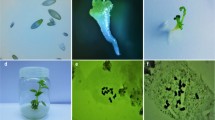Abstract
Crop improvement in bahiagrass (Paspalum notatum Flüggé) is limited by apomixis in most natural tetraploids, however, diploid sexual types occur. Production of sexual tetraploids by chromosome doubling will allow hybridization with apomictic tetraploids. Diploid bahiagrass (Paspalum notatum Flüggé) embryogenic callus tissue was exposed to three concentrations of three antimitotic chemical agents, colchicine, oryzalin and trifluralin. Callus was generated to plants and ploidy was evaluated by stomata size, mitotic chromosome counts, and flow cytometry. A total of 310 plants were verified as tetraploid of 1,432 plants that reached transplanting size. All treatments yielded 4x plants. The mean percentage success over all treatments was 22%, with means of 31% for oryzalin, 24% for colchicine and 16% for trifluralin. The high rates of success indicate that all agents can be successfully used to double chromosome numbers in bahiagrass. The percentage of 4x plants ranged from 9% (20 μM trifluralin) to 43% (20 μM oryzalin). Several treatments adversely affected regeneration. Mitotic chromosome counts are difficult and labor intensive in bahiagrass. Therefore, leaf stomata measurements were used as a preliminary screen. Data gave a bimodal distribution with overlapping tails and based on chromosome counts would have given an error rate of 12%. Flow cytometry analysis of regenerated plants resulted in mean nucleus fluorescence distributions consistent with control diploid or tetraploid values. These values agreed with chromosome counts, and this method is recommended for determining bahiagrass ploidy level. Research goals and available resources should be taken into consideration when selecting a treatment for chromosome doubling in bahiagrass.



Similar content being viewed by others
References
Acuña CA, Blount AR, Quesenberry KH, Hanna WW, Kenworthy KE (2007) Reproductive characterization of bahiagrass germplasm. Crop Sci 47:1711–1717
Acuña CA, Blount AR, Quesenberry KH, Kenworthy KE, Hanna WW (2009) Bahiagrass tetraploid germplasm: reproductive and agronomic characterization of segregating progeny. Crop Sci 49:581–588
Blakeslee AF (1939) The present and potential service of chemistry to plant breeding. Am J Bot 26:163–172
Bradley MV, Goodspeed TH (1943) Colchicine induced allo- and autopolyploidy in nicotiana. Proc Natl Acad Sci USA 29:295–301
Brewbaker JL (1952) Colchicine induction of tetraploids in Trifolium. Agron J 44:592–594
Burton GW (1948) The method of reproduction in common bahia grass, Paspalum notatum. J Am Soc Agron 40:443–452
Burton GW (1955) Breeding Pensacola bahiagrass, Paspalum notatum: I. Method of reproduction. Agron J 47:311–314
Burton GW (1989) Registration of ‘Tifton 9’ Pensacola bahiagrass. Crop Sci 29:1326
Forbes I, Burton GW (1961) Cytology of diploids, natural and induced tetraploids, and intraspecific hybrids of bahiagrass, Paspalum notatum Flügge. Crop Sci 1:402–406
Gamborg OL, Miller RA, Ojima K (1968) Nutrient requirements of suspension cultures of soybean root cells. Exp Cell Res 50:151–158
Geoffriau E, Kahane R, Bellamy C, Rancillac M (1997) Ploidy stability and in vitro chromosome doubling in gynogenic clones of onion (Allium cepa L.). Plant Sci 122:201–208
Hansen NJP, Andersen SB (1996) In vitro chromosome doubling potential of colchicine, oryzalin, trifluralin and AMP in Brassica napus microspore culture. Euphytica 88:159–164
Hansen AL, Gertz A, Joersbo M, Anderson SB (1998) Antimicrotubule herbicides for in vitro chromosome doubling in Beta vulgaris L. ovule culture. Euphytica 101:231–237
Hassawi DS, Liang GH (1991) Antimitotic agents: effects on double haploid production in wheat. Crop Sci 31:723–726
Hugdahl JD, Morejohn LC (1993) Rapid and reversible high-affinity binding of the dinitroanaline herbicide oryzalin to tubulin from Zea mays L. Plant Physiol 102:725–740
Kermani MJ, Sarasan Y, Roberts AV, Yokoya K, Westworth J, Sieber VK (2003) Oryzalin-induced chromosome doubling in Rosa and its effect on plant morphology and pollen viability. Theor Appl Genet 107:1195–1200
Miles JW, do Valle CB (1996) Manipulation of apomixis in Bracharia breeding. In: Miles JW, Mass BL, do Valle CB (eds) Bracharia biology, agronomy, and improvement. CIAT/EMBRAPA-CNPQ, Brasilia/Campo Grande, Brazil. CIAT Publication 259, pp 164–177
Morejohn LC, Bureau TE, Mole-Bajer J, Bajer AS, Fasket DE (1987) Oryzalin, a dinitroaniline herbicide, binds to plant tubulin and inhibits microtubule polymerization in vitro. Planta 172:252–264
Murshige T, Skoog F (1962) A revised medium for rapid growth and bioassays with tobacco tissue cultures. Plant Physiol 15:473–497
Quarin CL, Espinoza F, Martinez EJ, Pessino SC, Bovo OA (2001) A rise of ploidy level induces the expression of apomixis in Paspalum notatum. Sex Plant Reprod 13:243–249
Smith RL, Grando MF, Li YY, Seib JC (2002) Transformation of bahiagrass (Paspalum notatum Flugge). Plant Cell Rep 20:1017–1021
Taylor NL, Anderson MK, Quesenberry KH, Watson L (1976) Doubling the chromosome number of Trifolium species using nitrous oxide. Crop Sci 16:516–518
Wan Y, Duncan RD, Rayburn AL, Petolino JF, Widholm JM (1991) The use of antimicrotubule herbicides for the production of doubled haploid plants from anther-derived maize callus. Theor Appl Genet 81:205–211
Author information
Authors and Affiliations
Corresponding author
Rights and permissions
About this article
Cite this article
Quesenberry, K.H., Dampier, J.M., Lee, Y.Y. et al. Doubling the chromosome number of bahiagrass via tissue culture. Euphytica 175, 43–50 (2010). https://doi.org/10.1007/s10681-010-0165-4
Received:
Accepted:
Published:
Issue Date:
DOI: https://doi.org/10.1007/s10681-010-0165-4




